Hua C., Wong R. Differential Equations and Asymptotic Theory in Mathematical Physics
Подождите немного. Документ загружается.


112
Then,
for
n
2
2,
there
is
an n-spike solution to
(2.4)
of
the
form
n-1
u
N
uc(x)
=
C
w
[~-'(x
-
xj)]
-
(n
-
1)
s
,
(2.25)
j=O
where
xj
is
given
by
(2.26)
1
1
xjN-l+-
qi
-
(qr
+
qi)(
1
+
2j)
,
j
=
0,
. . .
,
n
-
1
.
n
Here
ql
and
qr
are defined
by
(2.27)
For the Neumann problem where
~1
=
K,
=
0,
(2.26) shows that
xj
=
-l+(2j
-
l)/n, for
j
=
0,.
. . ,
n-1,
so
that
dj
=
2/n
for
j
=
1,.
. .
,
n-1
and
do
=
d,
=
l/n. This symmetric spike spacing for the Neumann problem
also follows readily from the "time-map" associated with the phase-plane.
2.2.
Interior Spike Solutions: Boundary Layers
We now construct n-spike solutions to
(2.1)
for the boundary data
U(-1)
=
UL
,
U(1)
=
UR
1
(2.28)
where
s
<
u~,
UR
<
urn
(see Fig. 1).
A
composite expansion for an n-spike
solution has the form
n-1
u
N
uc(x)
C
w
[E-'(,
-
zj)]
-
(n
-
1)
s
+
[wL
(E-'(x
+
1))
-
S]
j=O
+
[WR
(&-1(1-
x))
-
s] .
(2.29)
The boundary layer terms
w~(<)
and
w~(<)
for
<
2
0
at the left and right
endpoints, respectively, are portions of the homoclinic orbit, which satisfy
w;
+
Q(wL)
=
o
,
wL(0)
=
UL
,
wL(<)
N
s
+
cLePuE
as
E
---*
00
,
(2.30a)
wk
+
Q(wR)
=
0
,
w~(0)
=
UR,
w~(<)
N
s
+
cReFUE
as
<
4
CO,
(2.30b)
for some constants
cL
>
0
and
CR
>
0.
From the phase-plane, it is clear
that there are two solutions to each of (2.30a) and (2.30b). One solution
decreases monotonically to
s,
while the other first increases to
urn
and then
decreases to
s.
Therefore, there are two values for
c~
and for
CR.

113
We substitute
u
=
u,
+
R
into
(2.1),
where
R
<<
1.
In analogy with
(2.18),
we obtain that
R
satisfies
n-1
R"
+
Q'(uc)
R
=
E
f
C
Q
[w(?/i)]
-
Q(uc)
+
Q[wR(-Y~)]
+
Q
[wL(Y-I)]
7
i=O
(2.3
la)
~(-1)
-Ce-uE-ldo.
,
R(l)
N
-ce-"€
dn.
(2.31
b)
Here
yi
=
~-l(x
-
xi),
for
i
=
-1
,...
,n,
where
5-1
=
-1
and
x,
=
1.
By eliminating the projection of
R
onto the eigenspace associated with the
exponentially small eigenvalues, the spike layer locations satisfy
(,Y,$~)~
B~
=E2c
e-u&-ldn+~(l)-e-"€-'do$~(-1)),
j=~,
...,
n-I,
(2.32)
where
$j
N
w'(yj)
near the
jth
spike.
The analysis of
(2.32)
differs in two main respects from the analysis
in Sec.
2.1.
Firstly, to evaluate
(E,+j),
we note that the interior spikes
closest to the endpoints, corresponding to
j
=
0
and
j
=
n
-
1,
now have
two nearest neighbors instead of only one. Specifically, for the spike at
x
=
50,
the nearest neighbors are the spike at
x
=
x1
and the boundary
layer solution
WL.
A
similar situation occurs for the spike nearest the
right endpoint. Secondly, it can be shown that for each
j
=
0,.
. . ,
n
-
1
the boundary term
Bj
in
(2.32)
is asymptotically smaller than
(E,$j).
In
contrast, for the problem in Sec.
2.1,
the contribution from
Bo
and
B,-1
had to be retained. Therefore, we can set
Bj
=
0
for
j
=
0,.
. .
,
n
-
1
in
(2.32),
to obtain that the layer locations asymptotically satisfy
(E,
+j)
N
0.
By calculating
(E,
+j)
asymptotically as in Sec.
7.1
of
[loo],
we obtain, in
analogy with
(2.24),
that the inter-spike separations
dj
satisfy
-1
(
1
CRe-~~-ldn
Ce-~~-ldn-l
(2.33a)
Ce-u~-ldl CLe-u~-'do.
e-~~-'d,+l
e-u~-'d,
,
j
=
1,
...,
n-2.
(
2.33
b)
By solving
(2.33)
explicitly, we obtain the following result:
Proposition
2.4.
Let
E
<<
1
and consider
(2.1)
with the Dirichlet condi-
tions
u(-1)
=
UL
and
u(1)
=
u~,
where
s
<
u~,u~
<
u,.
Then, there
is
an n-spike solution
of
the
form
n-1
u
N
u,(x)
=
C
w
[~-l(x
-
xj)]
-
(n
-
1)
s
+
[wL
(~-'(x
+
1))
-
s]
j=O
+
[WR
(E-l(l-
x))
-
s] ,
(2.34)
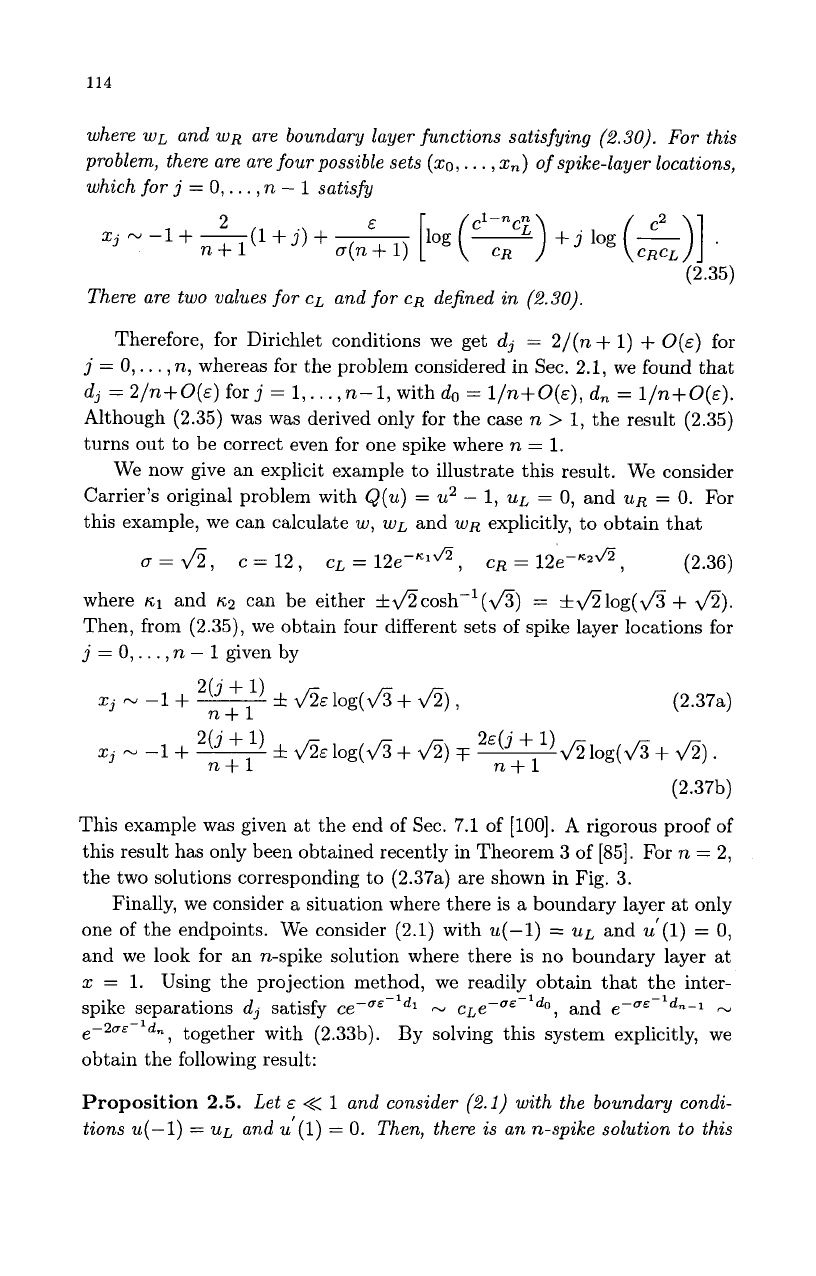
114
where
WL
and
WR
are boundary layer functions satisfying
(2.30).
For this
problem, there are are four possible sets
(50,.
. .
,
xn)
of
spike-layer locations,
which for
j
=
0,.
. .
,n
-
1
satisfy
2
E
n+l u(n
+
1)
xj
-
-1
+
-(I
+j)
+
(2.35)
Th,ere are two ualues for
CL
and for
CR
defined
in
(2.30).
Therefore, for Dirichlet conditions we get
dj
=
2/(n
+
1)
+
O(E)
for
j
=
0,.
.
. ,
n, whereas for the problem considered in Sec. 2.1, we found that
dj
=
2/n+O(~) for
j
=
1,.
. .
,n-1,
with
do
=
l/n+O(E),
dn
=
l/n+O(€).
Although (2.35) was was derived only for the case
n
>
1,
the result (2.35)
turns out to be correct even for one spike where
n
=
1.
We now give an explicit example to illustrate this result. We consider
Carrier's original problem with
Q(u)
=
u2
-
1,
UL
=
0,
and
UR
=
0.
For
this example, we can calculate
w,
WL
and
WR
explicitly, to obtain that
ff
=
Jz,
c=
12,
CL
=
12e-4,
CR
=
12e-"2JZ, (2.36)
where
~1
and
~2
can be either *ficosh-'(fi)
=
*&log(&f
+
a).
Then, from (2.35), we obtain four different sets of spike layer locations for
j
=
0,.
. .
,n
-
1
given by
xj--1+-
2(j
+
l)
f
Jz€log(&+
Jz),
n+l
(2.37a)
xj--1+---
2E(j
+
l)
Jz
log(
&
+
Jz)
.
2(j
+
l)
f
Jz€
log(&
+
Jz)
ntl
n+l
(2.37b)
This example was given at the end of Sec. 7.1 of
[loo].
A
rigorous proof of
this result has only been obtained recently in Theorem
3
of [85]. For
n
=
2,
the two solutions corresponding to (2.37a) are shown in Fig. 3.
Finally, we consider
a
situation where there is a boundary layer
at
only
one
of
the endpoints. We consider (2.1) with
u(-1)
=
UL
and u'(1)
=
0,
and we look for an n-spike solution where there is no boundary layer at
x
=
1. Using the projection method, we readily obtain that the inter-
spike separations
dj
satisfy
~e-~~-~~~
-
c~e-"-'~~,
and
e-uE-ldn-l
-
e-2uE-'dn, together with (2.3313). By solving this system explicitly, we
obtain the following result:
Proposition
2.5.
Let
E
<<
1
and consider
(2.1)
with the boundary condi-
tions
u(-1)
=
UL
and
~'(1)
=
0.
Then, there is an n-spike solution
to
this
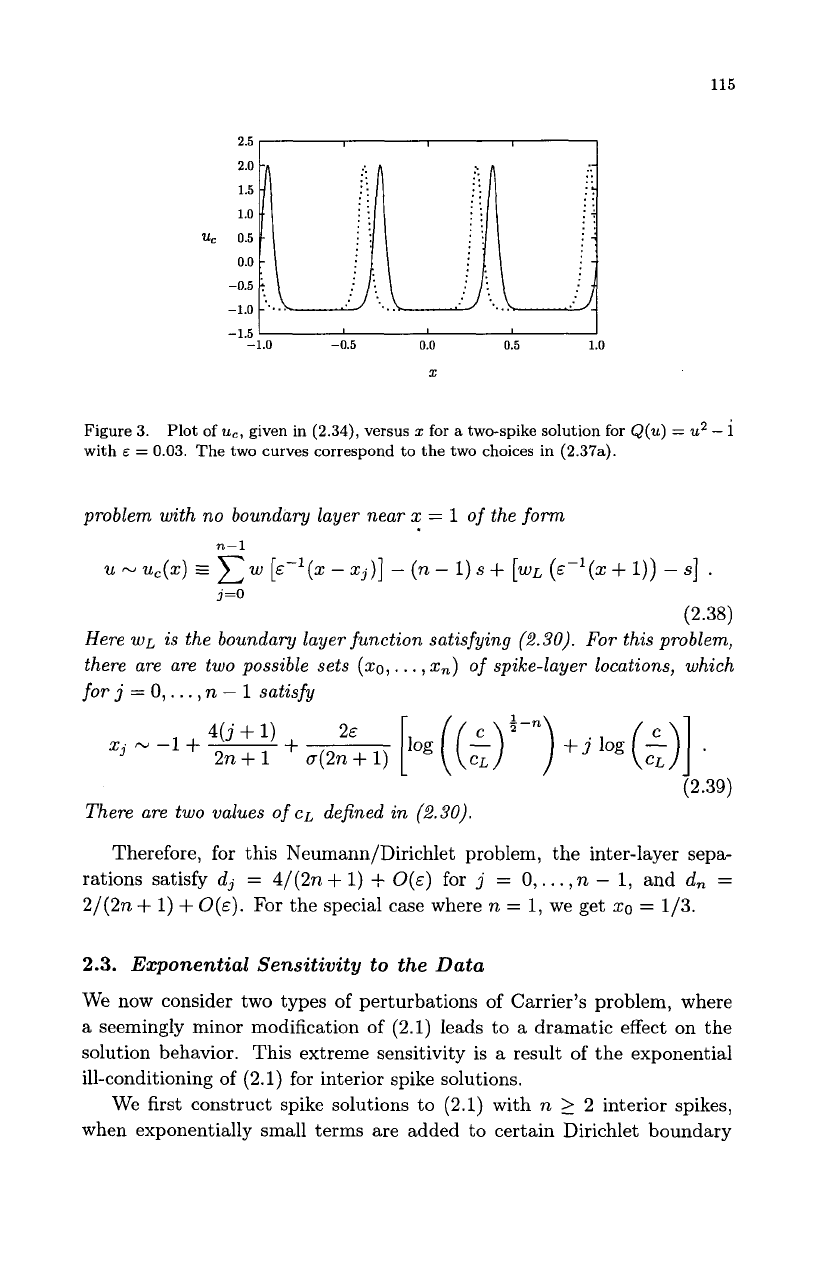
115
2.5
I
I
I
I
I
2.0
1.5
1.0
UC
0.5
0.0
-0.5
-1.0
-1.5
-1.0
-0.5
0.0
0.5
1.0
X
Figure
3.
with
E
=
0.03.
The two curves correspond to the two choices in
(2.37a).
Plot
of
uc,
given in
(2.34),
versus
I
for
a
two-spike solution for
Q(u)
=
u2
-
1
problem with no boundary layer near
x
=
1
of
the
form
n-1
u
u~x)
E
C
w
[E-'(x
-
xj)]
-
(n
-
1)
s
+
[wL
(EC'(X
+
I))
-
s]
.
j=O
(2.38)
Here
WL
is
the boundary layer function satisfying
(2.30).
For this problem,
there are are two possible sets
(50,.
.
. ,x,)
of
spike-layer locations, which
for
j
=
0,
. . .
,
n
-
1
satisfy
4(j
+
1)
xj
N
-1
+
~
2n
+
1
+
42n
+
1)
(2.39)
There are two values
of
CL
defined
in
(2.50).
Therefore, for this Neumann/Dirichlet problem, the inter-layer sepa-
rations satisfy
dj
=
4/(2n
+
l)
+
O(E)
for
j
=
0,.
. .
,
n
-
l,
and
d,
=
2/(2n
+
1)
+
O(E).
For the special case where
n
=
1,
we get
xo
=
1/3.
2.3.
Exponential Sensitivity to the Data
We now consider two types of perturbations of Carrier's problem, where
a
seemingly minor modification
of
(2.1)
leads to
a
dramatic effect on the
solution behavior. This extreme sensitivity is
a
result of the exponential
ill-conditioning of
(2.1)
for interior spike solutions.
We first construct spike solutions to
(2.1)
with
n
2
2
interior spikes,
when exponentially small terms are added to certain Dirichlet boundary

116
conditions. Specifically, we consider
(2.1)
with
u(-1)
=
s
+
Ae-uE-l/n
,
u(
1)
=
s
+
A
e-uE-l/n
.
(2.40)
Here
A
>
0
and is
O(
1)
as
E
4
0.
This problem models the initial formation
of boundary layers near the endpoints. For the special case
Q(u)
=
u2
-
1,
and for two interior spikes, such a problem was analyzed using variational
methods in
[51],
where it was shown that a bifurcation can occur if
A
exceeds a threshold. The general case for arbitrary
n
2
2,
and for arbitrary
Q(u)
of the form shown in Fig.
1,
was treated using the projection method
in
$6.1
of
[loo],
where the following result was obtained:
Proposition
2.6.
Let
E
<<
1
and consider (2.1) with the boundary condi-
tions (2.40). Consider an n-spike solution
of
the
form
(2.25) with
n
2
2.
These equilibria exhibit a saddle-node bifurcation structure as
A
is varied.
In
particular, there are four possible sets
(20,.
. .
,
xn)
of
spike-layer loca-
tions when
A
>
2c,
two sets when
A,(n)
<
A
<
2c,
and no such sets when
A
<
A,(n).
Here
A,(n)
is defined
bj
(1
-n)
/2n
n-1
As(~)=~C(%)
(x)
,
n=2,3,.
(2.41)
Therefore, by perturbing the boundary conditions by exponentially
small terms, new solutions can be created by saddle-node bifurcations. To
illustrate this result, let
Q(u)
=
u2
-
1.
Then, c
=
12,
and
A,(2)
=
21.06
from
(2.41).
Therefore, for
E
<<
1,
we predict that there are no two-spike
solutions to
(2.1)
with boundary conditions
(2.40)
when
0
<
A
<
21.06.
The next problem considers the effect of modifying a coefficient in the
differential operator in
(2.1)
by an exponentially small but spatially varying
term. In
[46]
a
solution with one interior spike was constructed for
(2.42a)
where, for some constants
v
and
q
>
0,
ri
=
K(X;
E)
has the form
-1
K(X;E)
=
1
+
2'g(x)e-E
4.
(2.42
b)
Here
g(x)
is a smooth function. In
[46]
the projection method was used to
determine the location of
a
spike for an interior one-spike solution with no
boundary layers. The result is summarized
as
follows:
Proposition
2.7.
Let
E
<<
1
and consider a solution to (2.42) with one
interior spike. The solution is given asymptotically
by
u
N
w
[E-'(x
-
XO)]
,
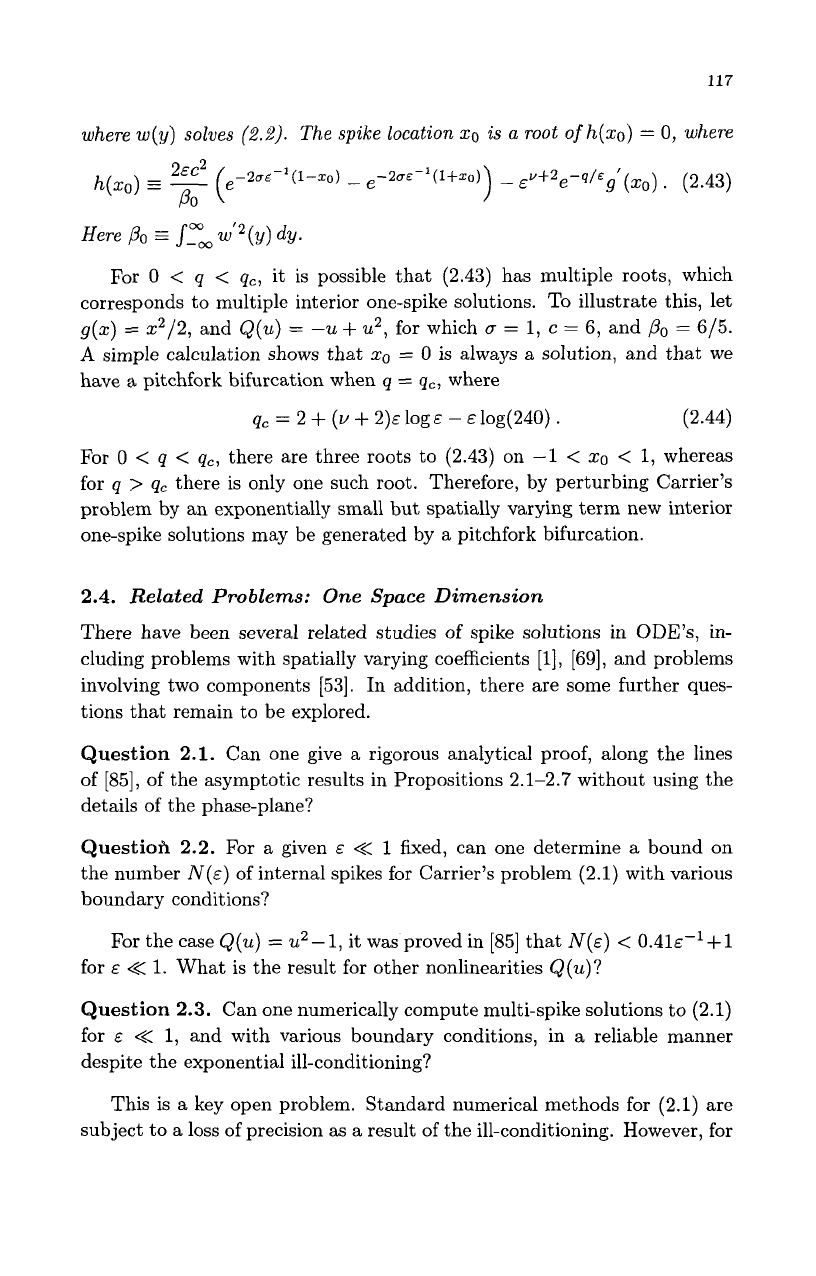
117
where
w(y)
solves
(2.2).
The spike location
xo
is
a
root
of
h(x0)
=
0,
where
For
0
<
q
<
qc,
it is possible that (2.43) has multiple roots, which
corresponds to multiple interior one-spike solutions. To illustrate this, let
g(x)
=
x2/2, and
Q(u)
=
-u
+
u2,
for which
CJ
=
1,
c
=
6, and
Po
=
6/5.
A
simple calculation shows that
xo
=
0
is always a solution, and that we
have
a
pitchfork bifurcation when
q
=
qc,
where
qc
=
2
+
(V
+
2)~
log
E
-
E
log(240)
.
(2.44)
For
0
<
q
<
qc,
there are three roots to (2.43) on
-1
<
xo
<
1,
whereas
for
q
>
qc
there is only one such root. Therefore, by perturbing Carrier's
problem by an exponentially small but spatially varying term new interior
one-spike solutions may be generated by a pitchfork bifurcation.
2.4.
Related Problems: One Space Dimension
There have been several related studies of spike solutions in
ODE'S,
in-
cluding problems with spatially varying coefficients
[l],
[69], and problems
involving two components [53]. In addition, there are some further ques-
tions that remain to be explored.
Question
2.1.
Can one give
a
rigorous analytical proof, along the lines
of
[85],
of
the asymptotic results in Propositions 2.1-2.7 without using the
details of the phase-plane?
Questiolf
2.2.
For a given
E
<<
1
fixed, can one determine
a
bound on
the number
N(E)
of internal spikes for Carrier's problem (2.1) with various
boundary conditions?
For the case
Q(u)
=
u2
-
1,
it was proved in
[85]
that
N(E)
<
0.4~~
+
1
for
E
<<
1.
What is the result for other nonlinearities
Q(u)?
Question
2.3.
Can one numerically compute multi-spike solutions to (2.1)
for
E
<<
1,
and with various boundary conditions, in a reliable manner
despite the exponential ill-conditioning?
This is a key open problem. Standard numerical methods for (2.1) are
subject to a loss of precision as a result of the ill-conditioning. However, for
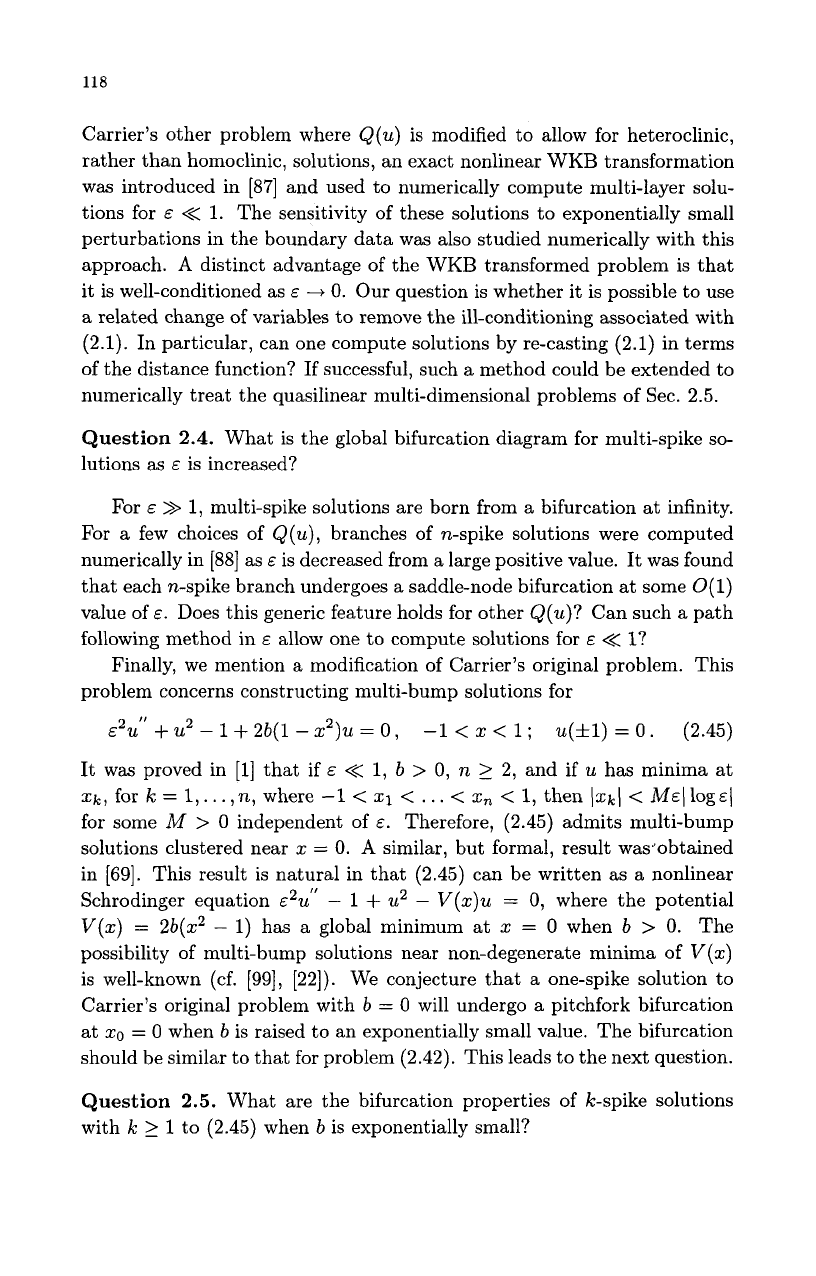
118
Carrier’s other problem where
Q(u)
is modified to allow for heteroclinic,
rather than homoclinic, solutions, an exact nonlinear WKB transformation
was introduced in
[87]
and used to numerically compute multi-layer solu-
tions for
E
<<
1. The sensitivity of these solutions to exponentially small
perturbations in the boundary data was also studied numerically with this
approach.
A
distinct advantage of the WKB transformed problem is that
it is well-conditioned as
E
-i
0.
Our question is whether it is possible to use
a related change of variables to remove the ill-conditioning associated with
(2.1). In particular, can one compute solutions by re-casting (2.1) in terms
of the distance function? If successful, such
a
method could be extended to
numerically treat the quasilinear multi-dimensional problems of Sec. 2.5.
Question
2.4.
What is the global bifurcation diagram for multi-spike
so-
lutions as
E
is increased?
For
E
>>
1,
multi-spike solutions are born from
a
bifurcation at infinity.
For
a
few choices of
Q(u),
branches of n-spike solutions were computed
numerically in
[88]
as
E
is decreased from a large positive value. It was found
that each n-spike branch undergoes
a
saddle-node bifurcation at some
O(
1)
value of
E.
Does this generic feature holds for other
Q(u)?
Can such
a
path
following method in
E
allow one to compute solutions for
E
<<
I?
Finally, we mention a modification of Carrier’s original problem. This
problem concerns constructing multi-bump solutions for
E’U”
+
u2
-
1
+
2b(l
-
II:’)~
=
0,
-1
<
II:
<
1
;
u(f1)
=
0.
(2.45)
It
was proved in
[l]
that if
E
<<
1,
b
>
0,
n
2
2,
and if
u
has minima at
zk,
for
k
=
1,.
. .
,n,
where
-1
<
21
<
. . .
<
z,
<
1,
then
IZk(
<
ME(1ogEI
for some
M
>
0
independent of
E.
Therefore, (2.45) admits multi-bump
solutions clustered near
II:
=
0.
A
similar, but formal, result wasobtained
in
[69].
This result is natural in that (2.45) can be written as a nonlinear
Schrodinger equation
E’U”
-
1
+
u2
-
V(II:)U
=
0,
where the potential
V(z)
=
2b(z2
-
1)
has a global minimum at
z
=
0
when
b
>
0.
The
possibility of multi-bump solutions near non-degenerate minima
of
V(z)
is well-known (cf.
[99],
[22]). We conjecture that
a
one-spike solution to
Carrier’s original problem with
b
=
0
will undergo a pitchfork bifurcation
at
II:~
=
0
when
b
is raised to an exponentially small value. The bifurcation
should be similar to that for problem (2.42). This leads to the next question.
Question
2.5.
What are the bifurcation properties of k-spike solutions
with
k
2
1
to (2.45) when
b
is exponentially small?

119
2.5.
Spikes
for
Quasilinear Elliptic
PDE
In this subsection, we construct spike solutions for
E~A~+Q(~)=O,
x~~;
a,u=o
xEaR,
(2.46)
where
R
is a bounded, simply-connected, domain in
RN,
with
N
>
1.
We
assume that
Q(s)
=
0,
with
Q’(s)
<
0,
and that there exists
a
unique
radially symmetric ground-state solution
w(p),
with
p
=
Iyl,
that satisfies
//
(N.-1)
I
P
w
+-
w
+
Q(w)
=
0,
p
L
0;
w(0)
>
0,
(2.47a)
(2.4713)
where
c
>
0
and
=
-Q’(s)
.
An important example
is
Q(u)
=
--u+u,p
for
1
<
p
<
p,,
where
p,
=
is the Sobolev exponent for
N
2
3,
and
p,
=
m
if
N
=
2. For this case,
w(p)
satisfies (1.7). Equation (2.46) is the
multi-dimensional version of Carrier’s problem (2.1), where
w(p)
replaces
the homoclinic solution
w(y).
The study of spike solutions to (2.46) was largely initiated in the pi-
oneering work of Ni and Takagi (cf. [68], [76], [77]). An earlier survey of
results for (2.46), and for some related problems, is given in [78].
We now follow [78] and give
a
rough summary
of
the results
of
[76] and
[77], characterizing the “least-energy solution” of (2.46) for
Q(u)
=
-u+uP,
and with
u
>
0
in
R.
For this problem, the energy functional for (2.46) is
-(N-1)/2
-up
w’(0)
=
0,
w
N
s
+
cp
e
,
as
p+m,
[
Ill2
where
u+
=
max(u,
0).
As argued in [76] and [77],
J,
has a minimum
when restricted to the set of solutions of (2.46) with
u
>
0
in
R.
This
minimizing solution is called the “least-energy solution”. Since an interior
spike solution has, asymptotically, twice the energy of
a
boundary spike
solution, the least-energy solution must be
a
one-spike solution centered
at
some point on
do.
To determine the actual point
(,
E
dR
where the spike
concentrates,
a
two-term expansion for
JE
as
E
4
0
is required. For a spike
centered
at
c,
E
80,
it was shown in [77] that
(2.49)
where
C
is a positive constant independent of
E,
and
I(w)
is defined by
I(w)
=
LN
[;
(IVWl2
+w2)
-
-WP
1
P+l
1
dy.
(2.50)
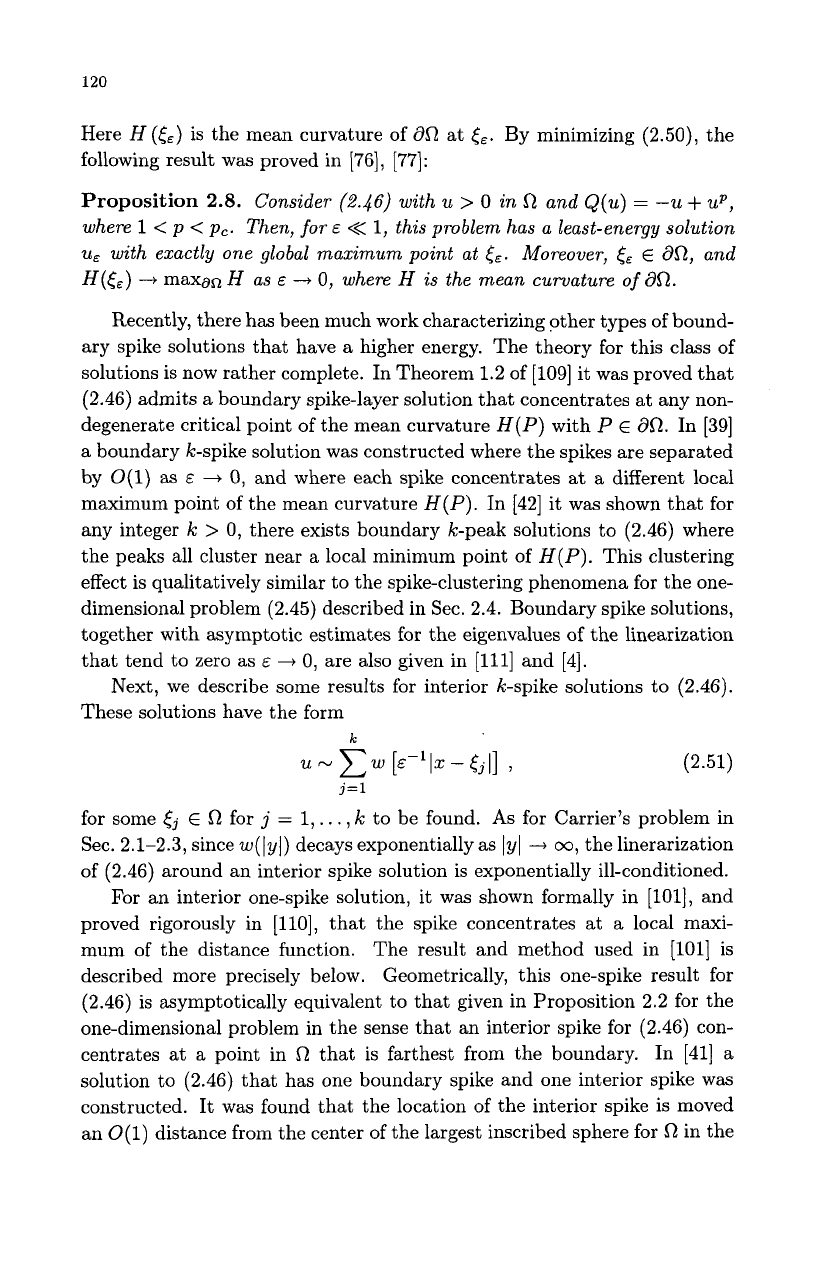
120
Here
H
(&)
is the mean curvature of
dR
at
&.
By minimizing (2.50), the
following result was proved in [76], 1771
:
Proposition
2.8.
Consider
(2.46)
with
u
>
0
in
R
and
Q(u)
=
-u
+
up,
where
1
<
p
<
p,. Then,
for
E
<<
1,
this problem has a least-energy solution
u,
with exactly one global maximum point at
&.
Moreover,
&
E
dR,
and
H(&)
--+
maxan
H
as
E
-+
0,
where
H
is
the mean curvature
of
do.
Recently, there has been much work characterizing other types of bound-
ary spike solutions that have
a
higher energy. The theory
for
this class of
solutions is now rather complete. In Theorem
1.2
of [lo91 it was proved that
(2.46) admits
a
boundary spike-layer solution that concentrates at any non-
degenerate critical point of the mean curvature
H(P)
with
P
E
80.
In [39]
a boundary k-spike solution was constructed where the spikes are separated
by 0(1)
as
E
+
0,
and where each spike concentrates
at
a
different local
maximum point of the mean curvature
H(P).
In [42] it was shown that for
any integer
Ic
>
0,
there exists boundary Ic-peak solutions to (2.46) where
the peaks all cluster near a local minimum point of
H(P).
This clustering
effect is qualitatively similar to the spike-clustering phenomena for the one-
dimensional problem (2.45) described in Sec. 2.4. Boundary spike solutions,
together with asymptotic estimates for the eigenvalues of the linearization
that tend to zero as
E
+
0,
are also given in
[lll]
and [4].
Next, we describe some results for interior k-spike solutions to (2.46).
These solutions have the form
k
(2.51)
j=l
for some
E
R
for
j
=
1,.
. .
,
Ic
to be found.
As
for Carrier’s problem in
Sec. 2.1-2.3, since
w(
Iyl)
decays exponentially as
IyI
-+
m,
the linerarization
of (2.46) around an interior spike solution is exponentially ill-conditioned.
For
an interior one-spike solution, it was shown formally in
[loll,
and
proved rigorously in [110], that the spike concentrates at
a
local maxi-
mum of the distance function. The result and method used in
[loll
is
described more precisely below. Geometrically, this one-spike result for
(2.46) is asymptotically equivalent to that given in Proposition 2.2 for the
one-dimensional problem in the sense that an interior spike for (2.46) con-
centrates
at
a point in
R
that is farthest from the boundary. In [41]
a
solution to (2.46) that has one boundary spike and one interior spike was
constructed.
It
was found that the location of the interior spike is moved
an O(1) distance from the center of the largest inscribed sphere for
R
in the
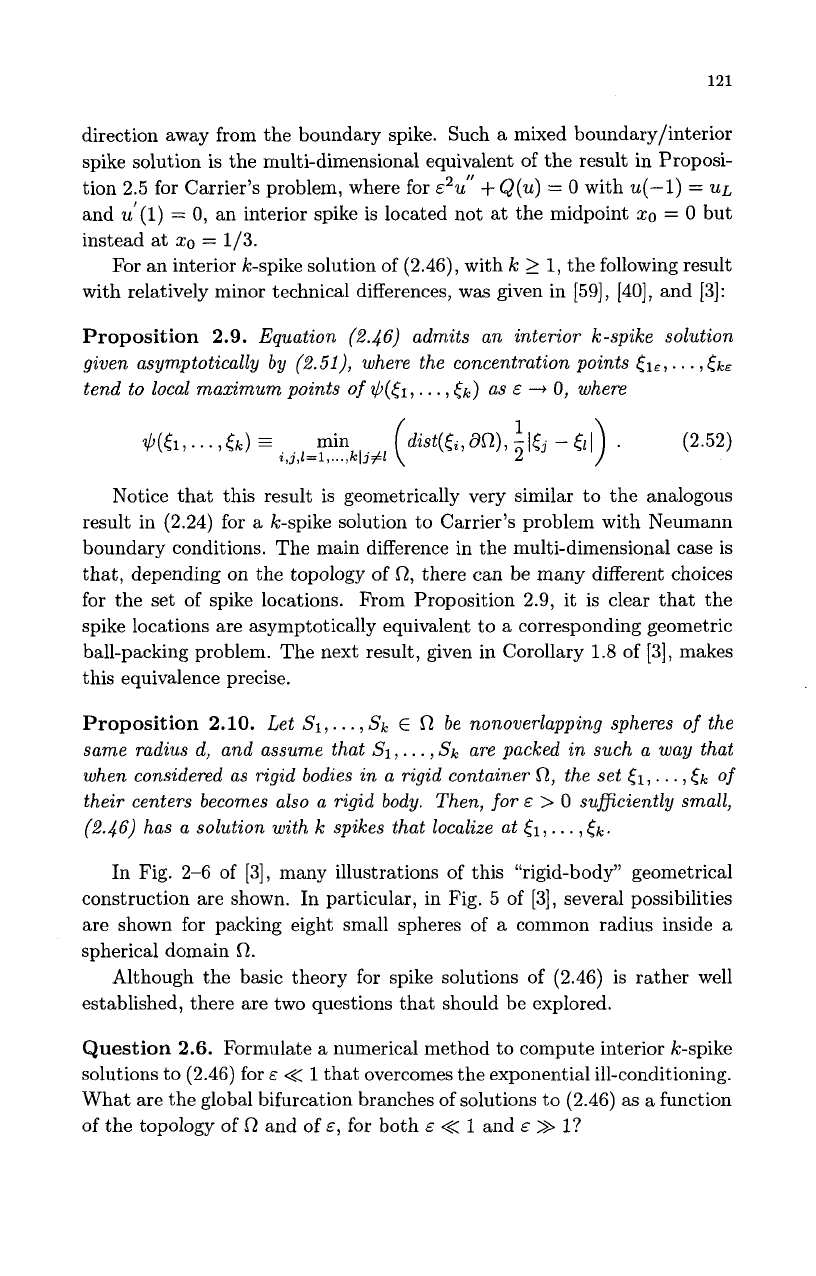
121
direction away from the boundary spike. Such a mixed boundary/interior
spike solution is the multi-dimensional equivalent of the result in Proposi-
tion 2.5 for Carrier’s problem, where for
E’U”
+
Q(u)
=
0
with u(-1)
=
UL
and u’(1)
=
0,
an interior spike
is
located not
at
the midpoint
20
=
0
but
instead
at
20
=
1/3.
For an interior k-spike solution of (2.46), with
k
2
1,
the following result
with relatively minor technical differences, was given in [59],
[40],
and [3]:
Proposition
2.9.
Equation (2.46) admits an interior k-spike solution
given asymptotically
by
(2.51),
where the concentration points
elE,.
. .
,
tend to local maximum points
of
$(El,
. . .
,
&)
as
E
-+
0,
where
$(ti,.
. .
,&)
=
min
i,j,l=l,
...,
klj#l
Notice that this result is geometrically very similar to the analogous
result in (2.24) for
a
k-spike solution to Carrier’s problem with Neumann
boundary conditions. The main difference in the multi-dimensional case is
that, depending on the topology of
0,
there can be many different choices
for the set of spike locations. F’rom Proposition 2.9, it is clear that the
spike locations are asymptotically equivalent to
a
corresponding geometric
ball-packing problem. The next result, given in Corollary 1.8 of
[3],
makes
this equivalence precise.
Proposition
2.10.
Let
5’1,.
. .
,
sk
E
0
be nonoverlapping spheres
of
the
same radius d, and assume that
5’1,.
. .
,
sk
are packed
in
such a way that
when considered as rigid bodies
in
a
rigid
container
0,
the set
&,
.
. .
,&
of
their centers becomes also a
rigid
body. Then,
for
E
>
0
sufficiently small,
(2.46) has a solution with
k
spikes that localize at
(1,
.
.
.
,
&.
In Fig. 2-6 of [3], many illustrations of this “rigid-body” geometrical
construction are shown. In particular, in Fig. 5 of [3], several possibilities
are shown for packing eight small spheres of
a
common radius inside
a
spherical domain
R.
Although the basic theory for spike solutions of (2.46) is rather well
established, there are two questions that should be explored.
Question
2.6.
Formulate
a
numerical method to compute interior k-spike
solutions to (2.46) for
E
<<
1
that overcomes the exponential ill-conditioning.
What are the global bifurcation branches of solutions to (2.46)
as
a
function
of the topology
of
0
and of
E,
for
both
E
<<
1
and
E
>>
l?
